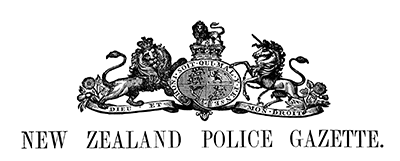- Magazines and Journals
- Explore
- New Zealand Police Gazette

New Zealand Police Gazette
Available issues
Background
Region
National
Available online
1877-1945
The first issue of the New Zealand Police Gazette came out on 2 July 1877. It replaced the various provincial police gazettes, which had previously been published by the respective provincial governments. Instead, once the provincial system ended, a national police gazette was created, published in Wellington, and distributed around the country’s police stations. Initially published fortnightly, it became a weekly publication from June 1904.
Like its predecessors, the New Zealand Police Gazette was a working tool for the police. It contained descriptions of crimes, wanted offenders, missing people, deserters, stolen items, and lost and found property, as well as notices about police appointments or promotions. It also published reports of discharged prisoners which, as well as listing the prisoner’s name, offence, date and place of trial, and sentence, included information about their occupation, height, eye and hair colour. From 1905 until 1917, relevant law reports were also included – after that the law reports were published as a separate title.
Mugshots had been taken by the New Zealand police since 1886, and from 1903 the police formalised the systems for recording information about criminals, which included compulsory fingerprinting and photographs. The first photograph to be included in the Police Gazette was published in the issue of 20 April 1904. It was a mugshot of John McKenzie, (real name James Ellis), who was wanted for the murder of Leonard Collinson. McKenzie was finally caught in December, and found guilty at his trial the following year and sentenced to death.
From 7 October 1908 the Gazette included pages of mugshots of discharged prisoners each month. Underneath every mugshot was a reference to the Gazette where the information about the prisoner’s crime, sentence and description had appeared; whether they had been finger-printed or not; and the classification numbers and letters that related to their fingerprints.
The first editor of the Police Gazette was Sergeant Patrick Fair, who was transferred from Dunedin to Wellington to manage the publication. His work on the Gazette was highly praised and he received a special promotion to Sergeant-Major in recognition of his work. The position of editor was based in the police headquarters, and it became part of the Criminal Registration Branch when that was established in 1911.
As well as providing information about criminals and crimes, the Gazette became the main communication tool between the national office and the staff around the country. For example in 1936, the Minister of Police, Peter Fraser, published a notice in the Gazette encouraging all police to join the newly formed Police Association, the police equivalent of a union. In the 1950s it was decided that there needed to be a way of the department communicating with police staff that was separate from the Gazette, and so the Police Bulletin “For the Force” started in 1957.
Changes to the Gazette in the 1960s meant that the monthly issue of prisoner photographs was replaced by a weekly photo supplement. The weekly supplement focused on people who were thought to be “actively engaged in crime”, overseas criminals who might be in New Zealand, and offenders who were wanted on charges.
The last Police Gazette was published in September 1991. It was replaced by “Ten-One”, which was still being published in 2019.
Copyright statement
NOTE this publication contains descriptions of crimes and photographs of deceased people.
The New Zealand Police Gazette from 1877-1944 is out of copyright.
The New Zealand Police Gazette for 1945 is still in copyright. You can reproduce in-copyright material from these issues for non-commercial use only under a Creative Commons Attribution-NonCommercial 4.0 International (CC BY-NC 4.0) licence. If you wish to use material from the Police Gazette for commercial purposes please contact Archives New Zealand.
For further advice on copyright please refer to the Copyright guide.
Acknowledgements
The National Library would like to thank Archives New Zealand and the New Zealand Police for their assistance with the digitisation of this title. If you reuse any material from these issues, please credit Archives New Zealand (ACIS 17653) as the source.
 Log in
Log in